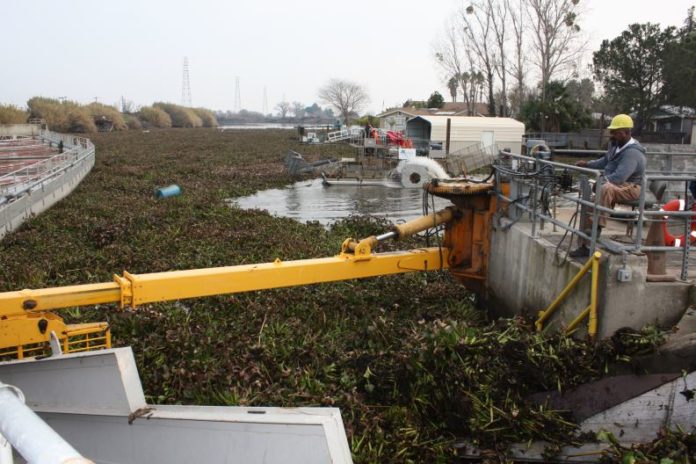The San Luis Delta Mendota Water Authority held its board of directors meeting on Thursday, June 9, 2022 at its Los Banos headquarters and on Zoom. On the dot Chairman Cannon Michael called the meeting to order at 9:30am as scheduled. He read through the Brown Act boiler plate and we all saluted the flag in person and remotely. Executive Director Federico Barajas led the roll call and introductions. The new Director of Finance Ray Tarka was recognized for his first full board meeting in that position.
The Meeting
The consent calendar was the first action item after public comment and there wasn’t much in the way of public comment. The calendar was passed and Barajas told the board Tarka needs to be officially recognized as the treasurer of the district, which the board did.
Transmission Bonds
Frances Mizuno updated the board on the San Luis Transmission Project saying the interest rates on the bonds has driven up the costs as has other variables such as the longer construction timeline. Bond consultant Lora Carpenter said the construction costs have come up to $317 million and the earliest date to energize the system is December of 2028. Moving water around California is one of the biggest uses of power in the state. I’ve been told the A.D. Edmonston pumping plant near the Grapevine that moves water from the California Aqueduct over the mountains into the Los Angeles basin is the single biggest user of electricity in the state. The San Luis Division of the Central Valley Project has large energy needs as well. Water has to be pumped from the Delta into the Delta Mendota Canal on its way to the San Luis Reservoir. A new power line and accompanying system is due.
Mizuno said the current lines are nearly 70-years old and the new lines should live at least as long. Carpenter was explaining the revenue stream from extra power sales as function of a 50-year funding term. The US Treasury bonds’ interest rates are bouncing around but in general heading upwards. It’s doubled the capital rate to more than $174 million if I understood.
The board began asking Mizuno and Carpenter questions. For instance, would the increased energy output offset the costs? That is possible. Barajas said there were concerns from other Central Valley Project contractors about the costs. I suspect he’s referring to Friant for the most part. He said there have been meetings with the US Bureau of Reclamation and others. The Bureau won’t sign an MOU to get this project off the ground without other CVP contractors to sign on. Barajas said there are folks who view this project in a “different light” but everyone sees the merits long term. There are still issues working their way through discussions. He said at the end of the day it will be a Bureau decision.
Someone asked what the cost to the grower will be. The farmer pays his district for O&M rates, the district pays SLDM, SLDM pays it on to the Bureau. Director Bill Diedrich said this is a worthwhile project but the upfront cost to the growers’ power bill in light of the uncertainty of water supplies may be too much to bear. He said as an individual grower he can’t see if the initial higher costs are survivable. That certainly needs to be worked out. Diedrich said he recognizes Mizuno has put her life into this for the past decade but he needs more info. Another director said before he can take this to the home board he does need a better idea of the costs. This is yet another example of the chaos being sown by the policy choices being made at state and federal levels regarding energy and other matters. My comment, not SLDM’s.
uncertainty of water supplies may be too much to bear. He said as an individual grower he can’t see if the initial higher costs are survivable. That certainly needs to be worked out. Diedrich said he recognizes Mizuno has put her life into this for the past decade but he needs more info. Another director said before he can take this to the home board he does need a better idea of the costs. This is yet another example of the chaos being sown by the policy choices being made at state and federal levels regarding energy and other matters. My comment, not SLDM’s.
Communications Plan
J. Scott Petersen reported on the communications plan saying a plan was adopted a couple of years ago. Many of the facets of the plan are underway such as more newsletters and special inhouse updates by the California Farm Water Coalition. Media Monitor is a news aggregator and is preferred by a majority of readers over other aggregate services. There is feedback that it is redundant and too frequent in distribution. Staff will begin to include an opt out feature. The analytics are being tracked and that will be compiled for the board to review. Eventually these products will be made available to the public through the SLDMWA website.
Petersen said there is a group to coordinate media outreach between the water authority and the member units. He said at this point in the plan the outreach is more directed to policy makers than the public. There is a line between grassroots advocacy as a public agency that can’t be crossed. He noted the partnership with the Cal Farm Water Coalition goes back for more than two decades. Michael said he wants to be involved in these efforts as each home board and as a group there are unique situations that need addressing.
Delta Mendota Canal
Barajas next spoke on the subsidence situation of the Delta Mendota Canal. Bob Martin, Facilities Manager SLDMWA and Christopher Park of CDM Smith, Inc. gave the board a PowerPoint presentation on the situation.
Martin first showed a map of the system from the Jones Plant to the Mendota Pool and the spatial relation to the member districts. The worst place is at mile marker 105 in Fresno County and the land has dropped 17 inches in the seven years between 2014 and 2021. The least subsidence is three inches at mile marker 75 in Merced County. There has been subsidence along the entire length of the canal if I interpret the graph correctly. These figures show what is happening along the DMC but not the surrounding land. The main cause is pumping the aquifer at an amount greater than available supplies can recharge. Replacing the antiquated fish screens in the Delta as proposed in the San Joaquin Valley Water Blueprint would allow more flows to address this problem throughout the Valley.
There were eight modifications identified by a USBR feasibility study to bring the DMC back to its original design capacity. Some of them are new concrete linings and embankment raises. They need 80-miles of this to get things going again. Pipelines and bridges need replacement and check structures, turnouts and drainage structures need modifications. Petersen verified the applicable GSAs are being consulted on this matter.
Martin showed some photos. The first one was a bridge that had its railings removed and replaced with concrete to keep the flows from flooding the road. Gates have been replaced to bring them up to the flow level. There was a photo of a pipeline that was originally two feet about the surface of the canal and now lies half a foot under water at high flows. There was a good question – if the bridge is sinking isn’t the canal sinking at the same rate? The answer is yes but the water elevation must be maintained the same for the gravity flow to work. There is very little freeboard left in the upper DMC. There are sections of the canal lower than others and they could be thought of as ponds.
Martin then showed a timeline that included surveys starting in 2019 to an estimated start date of 2024 to completion in 2034. The project is past the appraisal stage and currently in the planning stage. Then the final design will start later this year. The estimated cost for design is $3.3 million. The actual construction estimate and completion is $700 million according to the Bureau. If I understood. Costs are not going down but there are capacity restrictions on deliveries on the upper reach of the DMC. The intertie project between the DMC and the California Aqueduct is an interim solution.
Martin next spoke about funding and the total funding plan with contributions from the Bureau, the Department of Water Resources and SLDM is $8.9 million. He was asked who else benefits from the DMC and are they going to pay? Barajas said that is going to be the SLDMWA members.
Park then spoke saying the cultural resources evaluations are underway and there is consultation with impacted Native American Indian Tribes. The entire DMC is considered a potential historical resource by the State of California subject to possible historic preservation.
There is also another feasibility report being prepared to compare different outcomes from recovering the lost capacity to doing nothing. Environmental compliance for NEPA and CEQA are focused on the corrected facility being in compliance with existing permits. That would be good.
Barajas said the project components are being evaluated for prioritization. He also said both impacted state and local entities are being approached as partners for things such as improved bridge crossing and such. Park said there is a biological assessment being conducted and there is chance most of the permitting shouldn’t be new.
SLDM COO Pablo Arroyave said to expect a lot of discussion on funding this summer. He said a bill by Senator Dianne Feinstein would bring funding for a fourth of the costs for repairs of canals in the Valley. There is state funding available to match a third of the costs. Then there is bonding and increased O&M rates. Barajas said there are opportunities for smaller state and federal funding for the planning stage. Michael thanked the presenters and praised them for a good presentation.
Politics
Petersen said the legislation being tracked is in the packet. The National Water Resources Association is looking for a new executive director. There is a move to increase the habitat of endangered species to areas they don’t currently range so they can move due to climate changes and invasive species. The comment period goes into August.
In May the Bureau released knowledge based papers for the biops management. These include reverse flow for the Old and Middle San Joaquin River branches in the Delta, temperature control from Shasta and other matters. SLDM is submitting a science based response this week.
On the federal side Vice President Kamala Harris has launched a plan for global world water security. Hmm. It includes mention about lead pipes being poison but very little about growing food and water’s role in agriculture. Petersen used the word “disconcerting” as a descriptor.
The Bureau released a grant release announcement and there will be a June 15th webinar.
Congress has returned to Washington DC like flies on a pile of January Sixth hearings. Other things are an anticipated amount of work on gun law tinkering and some other creative ways to spend tax money while circumventing the Constitution. A hearing on western water was held and it included investment on infrastructure and is a precursor to the next Farm Bill. The Senate will hold a hearing next week on water in the west. A testimony by the Family Farm Alliance is slated to be a feature.
The House has moved a bill to direct the Army Corps of Engineers to conduct feasibility studies for projects in the Valley for flood control. There is a move to add water supply to the Army Corps facilities beneficial use. That is receiving some bipartisan support. Good for them.
The state budget surplus has ticked up slightly to $98 billion from the earlier $90 billion. There are hopes a chuck of that goes to water. Petersen said the State Board has issued curtailment on all manner of water rights including Post 1859 and will continue until significant precipitation occurs. There is an email list that must be joined to get more info on this.
In Sacramento there is a fight over how to deal with the inflation of gas prices and a $21 billion climate change package. That includes $100 million for canal subsidence and another $100 million on dam safety. AB 2239, (#?) that would have accelerated the Bay Delta Plan and screwed up all manner of things was defeated.
Ex Director Report
Barajas turned it over to Arroyave to talk about the BF Sisk Dam raise. A contract for management with the Hallmark Group has been entered into. Chuck Gardner from the Hallmark Group said he will keep things short since it’s his job to keep things on track timewise. He introduced a lady named Jessica Someone who will be the task master on the project. So if you hear from her you’re in some kind of trouble in relation to the project. He said the Hallmark Group is not only managing for construction but also benefits. That was interesting.
Arroyave said there is one more participant left to sign on the dotted line and then billing will commence. He also said if individual members would like direct contact with the Hallmark Group to let him know.
Barajas said there will be a stakeholder hearing later today to gather input for the new SLDMWA/Exchange Contractors headquarters and local museum. That’s going to be an exciting investment in Los Banos. Good for them. He also said the Bureau is celebrating a birthday on June 17th and you’re invited. Michael will be a speaker at the event which I think will be held at the San Luis Reservoir. DWR has approached the Bureau about CVP contractors engaging in a drinking water dialog if I understood correctly.
There is a tour being formed to take a look at things in Yuba County. SLDMWA and the Yuba County Water Authority are partners in water transfers. There are questions about why when it rains more there is less water for transfers. There will also be a meeting with the Sacramento Settlement Contractors as they are transfer partners as well.
COO Report
Arroyave said the Bureau will ramp down SJR transfers from Friant to the Exchange Contractors. He sees that happening next month. Extra water from Folsom Reservoir is one of the reasons.
Westlands Water District’s main man Tom Boardman gave the water ops report. He said Shasta is at 54 percent of average and 100,000 a/f lower than last year and 400,000 a/f lower than in 2014-15. That’s amazing in its own right. Folsom is doing better. It’s at 111 percent of average and up by 200,000 a/f over the April forecast. That will be released over the summer and allow more summer export supply pumping at the Jones Plant. There is a temporary order by the State Board restraining Bureau pumping that will expire next month. The Bureau is reporting the State Water Project owes 160,000 a/f under COA, the Cooperative Operating Agreement. There was federal water released from New Melones Reservoir for the benefit of the state side of the equation last year. There are 323,000 a/f on the federal side of San Luis Reservoir.
The graceful Anthea Hansen, GM of the powerful Del Puerto WD asked if Trinity River supplies are going to be player. Boardman said Trinity supplies are very low also and both it and Shasta have a ways to go to catch up to normal. Diedrich asked if there is much non-project water in SLR. He said 100,000 a/f maybe.
Committee & Agency Reports
Michael said there wasn’t much in the way of committee reports. Chris White, Executive Director of Ex Con said the O&M committee met but I didn’t catch anything earth shaking coming out of that.
Mike Wade, CFWC said Diedrich has been appearing on many television reports including the BBC. He said the issue has been more on food supply than climate change. He said the Wall Street Journal advertisement earlier this year has driven clicks to the web based messaging. He appeared on public radio yesterday in Los Angeles on the topic of the state purchasing senior water rights. John McManus of the Golden State Salmon Association was also on the program and that pairing created some serious debate. That should be interesting and I encourage you to listen in. You can get a link to a recording by going to the CFWC website.
interesting and I encourage you to listen in. You can get a link to a recording by going to the CFWC website.
Petersen reported on the San Joaquin Valley Water Blueprint. A vision and mission statement were written and agreed upon. A strategy plan for the next few years was written. The sort of sister effort of the Collaborative Action Plan is moving forward and a smaller term sheet with language more palatable to all the caucuses is being put out there. Michael said it is still reasonable to trust your representatives in this effort. Attorney Becca Ackroyd had nothing for open session.
Director William Bourdeau reported former Westlands WD director Don Devine passed away recently. Originally I had reported Don Peracchi had passed. My sincere apologies to the Devine family and Don Peracchi I’m glad you’re still with us.
DISCLAIMER OF RESPONSIBILITY; Waterwrights strives to provide clients with the most complete, up-to-date, and accurate information available. Nevertheless, Waterwrights does not serve as a guarantor of the accuracy or completeness of the information provided, and specifically disclaims any and all responsibility for information that is not accurate, up-to-date, or complete. Waterwrights’ clients therefore rely on the accuracy, completeness and timeliness of information from DAW entirely at their own risk. The opinions expressed in this report are those of the author and do not represent any advertisers or third parties.
most complete, up-to-date, and accurate information available. Nevertheless, Waterwrights does not serve as a guarantor of the accuracy or completeness of the information provided, and specifically disclaims any and all responsibility for information that is not accurate, up-to-date, or complete. Waterwrights’ clients therefore rely on the accuracy, completeness and timeliness of information from DAW entirely at their own risk. The opinions expressed in this report are those of the author and do not represent any advertisers or third parties.
ALL RIGHTS RESERVED. Copyright 2022 by WaterWrights.net/DAW
SAN LUIS & DELTA-MENDOTA WATER AUTHORITY was established in January of 1992 and consists of approximately 2,100,000 acres of 29 federal and exchange water service contractors within the western San Joaquin Valley, San Benito and Santa Clara counties. The governing body of the Authority consists of a 19-member Board of Directors classified into five divisions with directors selected from within each division. The main conveyance is the Delta-Mendota Canal that delivers approximately 3,000,000-acre feet of water within the Authority service area. Of this amount, 2,500,000-acre feet are delivered to highly productive agricultural lands, 150,000 to 200,000-acre feet for municipal and industrial uses, and between 250,000 to 300,000 acre-feet are delivered to wildlife refuges for habitat enhancement and restoration.
Board – Chairman: Cannon Michael,
Staff – Executive Director: Federico Barajas, COO: Pablo Arroyave, Attorney: Becca Ackroyd, Director of Water Policy: J. Scott Pedersen
Email: youtellus@sldmwa.org 209/826-9696
P.O. Box 2157 Los Banos, CA. 93635

































